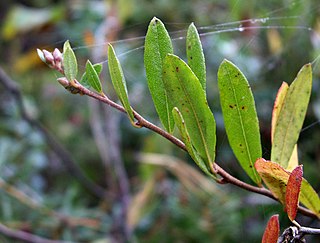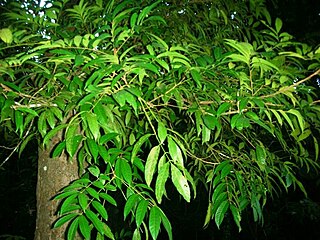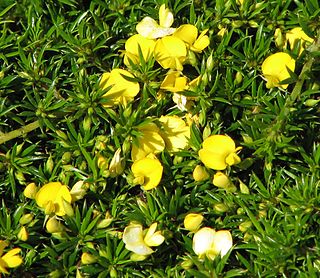
Colubrina is a genus of about 30 species of flowering plants in the family Rhamnaceae, native to warm temperate to tropical regions of Africa, the Americas, southern Asia, northern Australia, and the Indian Ocean islands. Common names include nakedwood, snakewood, greenheart and hogplum. The generic name is derived from the Latin word coluber, meaning "snake", and refers to the snake-like stems or stamens.

Exocarpos cupressiformis, with common names that include native cherry, cherry ballart, and cypress cherry, belongs to the sandalwood family of plants. It is a species endemic to Australia. Occasionally the genus name is spelt "Exocarpus" but it appears to be mostly no longer in use.

Chamaedaphne calyculata, known commonly as leatherleaf or cassandra, is a perennial dwarf shrub in the plant family Ericaceae and the only species in the genus Chamaedaphne. It is commonly seen in cold, acidic bogs and forms large, spreading colonies.

Aglaia spectabilis is a species of tree in the family Meliaceae, found from the Santa Cruz Islands in the southwest Pacific to Queensland (Australia), Southeast Asia, Yunnan (Zhōngguó/China) and the Indian subcontinent. It grows from a 1m shrub to an emergent 40m tall tree, depending on the habitat. Its wood is commercially exploited as timber, but otherwise is of poor quality with limited use. The fruit are eaten, and used in folk medicine. The seeds are large in comparison to other plants, and a major source of dispersal of the species are hornbills eating the fruit, flying away from the tree and regurgitating the seeds.

Callicarpa pedunculata is a shrub or small tree in the Lamiaceae family native to both Queensland and New South Wales.

Coprosma nitida, the mountain currant or shining currant, is a shrub species endemic to south-east Australia. It is a shrub with small, glossy leaves, occasional spines on the end of its branchlets, and small bright red-orange fruits.

Commersonia dasyphylla, commonly known as kerrawang, is a species of flowering plant of the family Malvaceae and is endemic to eastern continental Australia. It is a shrub with egg-shaped to lance-shaped with irregular edges and flowers in groups of up to 21, followed by hairy brown capsules.
Ischaemum nativitatis, commonly known as the Christmas Island duck-beak, is a tropical grass in the family Poaceae. It is endemic to Christmas Island, an Australian territory in the north-eastern Indian Ocean. The specific epithet comes from the Latin nativitas ("birth") referring to the birth of Christ, or Christmas, after the name of the island.

Pandanus christmatensis is a dioecious tropical plant in the screwpine genus. It is endemic to Christmas Island, an Australian territory in the north-eastern Indian Ocean. The specific epithet, "christmatensis", comes from its native locality.
Grewia insularis is a species of flowering plant in the Malvaceae, or mallow family, that is endemic to Christmas Island, an Australian territory in the north-eastern Indian Ocean. Its specific epithet is the Latin for insular, referring to its island location.
Peperomia rossii is a species of plant in the family Piperaceae. It is endemic to Christmas Island, an Australian territory in the northeastern Indian Ocean. Its specific epithet honours the Clunies-Ross family which established the Flying Fish Cove settlement on Christmas Island in 1888.
Claoxylon indicum is a dioecious flowering plant in the spurge family, Euphorbiaceae. The specific epithet comes from the Latin Indicus (Indian), referring to the locality of collection of the type specimen, which was probably Java, part of the Dutch East Indies at that time.

Hakea laevipes is a shrub in the family Proteaceae. A widespread species found growing on coastal and tableland locations mainly in eastern New South Wales, with scattered populations in south-eastern Queensland.

Petrophile pedunculata, commonly known as conesticks, is a species of flowering plant in the family Proteaceae and is endemic to New South Wales. It has divided leaves with needle-shaped pinnae and oval heads of sparsely hairy yellow or cream-coloured flowers, the heads on a peduncle 10–15 mm (0.39–0.59 in) long.

Pultenaea pedunculata, commonly known as matted bush-pea, is a species of flowering plant in the family Fabaceae and is endemic to south-eastern Australia. It is a prostrate, densely matted shrub with softly-hairy branches that often form roots, narrow elliptic leaves, and bright yellow and brick-red flowers.

Hakea microcarpa , commonly known as small-fruit hakea is a flowering plant in the family Proteaceae and is endemic to eastern Australia. It is a spreading shrub, often growing in woodlands, heathlands and near swamps in montane areas of eastern Australia.
Colubrina greggii is a species of flowering plant in the family Rhamnaceae, that is commonly known as the Sierra nakedwood or Gregg's colubrina. It is native to eastern Mexico, with a disjunct population in southern Texas in the United States. It is very similar to C. arborescens of Southern Florida and the Caribbean, and herbarium specimens of the two species are difficult to distinguish. The name honours American botanist Josiah Gregg, who collected the holotype near Monterrey, Nuevo León in 1848.

Hakea collina is a shrub in the Proteaceae native to eastern Australia. A small many branched shrub with gnarled branches with attractive cream-yellowish flowers.

Hakea pedunculata is a shrub or small tree in the family Proteaceae comprising approximately 150 species restricted to Australia. This species is found in the Far North region of Queensland and adjacent islands. It has flat, broadly egg-shaped leaves and white, cream or greenish flowers.
Grevillea scabrida is a shrub of the genus Grevillea native to an area in the north eastern Wheatbelt region of Western Australia.













